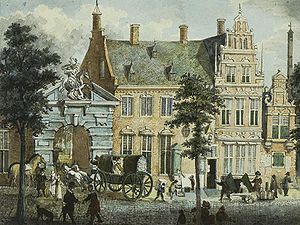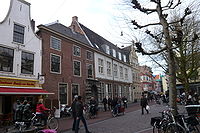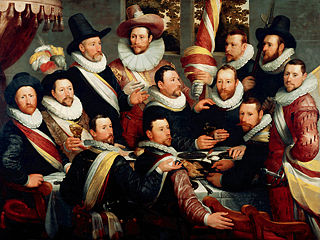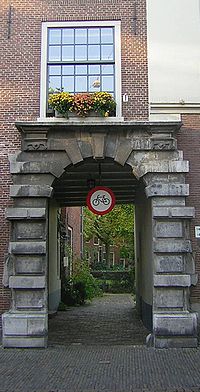
Proveniershuis
Encyclopedia


Hofje
A hofje is a Dutch word for a courtyard with almshouses around it. They have existed since the Middle Ages.A hofje provided housing for elderly people . They were privately funded, and served as a form of social security...
in Haarlem
Haarlem
Haarlem is a municipality and a city in the Netherlands. It is the capital of the province of North Holland, the northern half of Holland, which at one time was the most powerful of the seven provinces of the Dutch Republic...
, Netherlands
Netherlands
The Netherlands is a constituent country of the Kingdom of the Netherlands, located mainly in North-West Europe and with several islands in the Caribbean. Mainland Netherlands borders the North Sea to the north and west, Belgium to the south, and Germany to the east, and shares maritime borders...
.
History

Protestant Reformation
The Protestant Reformation was a 16th-century split within Western Christianity initiated by Martin Luther, John Calvin and other early Protestants. The efforts of the self-described "reformers", who objected to the doctrines, rituals and ecclesiastical structure of the Roman Catholic Church, led...
, when all church lands reverted to the city council. The Haarlem archives still have a first-hand account of one of the original nuns, Elisabeth Verhagen, who was moved to a house on the Begijnhof after the reformation. She complained of the plundering of her old cloister and the fact that all the sisters were split up and sent to live elsewhere. They had to make room for the St. Joris Doelen, or St. George Militia.
Golden Age target practise
In 1577, the city council refurbished the main buildings to house the schutterijSchutterij
Schutterij refers to a voluntary city guard or citizen militia in the medieval and early modern Netherlands, intended to protect the town or city from attack and act in case of revolt or fire. Their training grounds were often on open spaces within the city, near the city walls, but, when the...
called the "Oude schuts", and was called the St. Jorisdoelen, or St. George militia target field. The garden was converted to include two shooting lanes; one for bow and arrow, and one for the blunderbuss
Blunderbuss
The blunderbuss is a muzzle-loading firearm with a short, large caliber barrel, which is flared at the muzzle and frequently throughout the entire bore, and used with shot and other projectiles of relevant quantity and/or caliber. The blunderbuss could be considered to be an early form of shotgun,...
. The fancy St. Joris militiamen, who met more often together for shooting practise than for fighting or policing the streets, were painted by Frans Hals
Frans Hals
Frans Hals was a Dutch Golden Age painter. He is notable for his loose painterly brushwork, and helped introduce this lively style of painting into Dutch art. Hals was also instrumental in the evolution of 17th century group portraiture.-Biography:Hals was born in 1580 or 1581, in Antwerp...
several times.
From fancy inn to old age home

Romeyn de Hooghe
Romeyn de Hooghe was an important and prolific late Dutch Baroque, painter, sculptor, engraver and caricaturist.-Biography:...
made an etching of the building, calling it the Heren Logement, or gentlemen's hotel. In 1682 it had been restored by the city architect Lieven de Key
Lieven de Key
Lieven de Key was a famous Dutch renaissance architect in the Netherlands, mostly known today for his works in Haarlem.-Biography:...
for this purpose, with rooms being made for travelers in the top floors, and a main hall below. It was meant to be a chic refuge for travelers by coach, but this never quite succeeded, because the coaches never stopped there. In 1707 it became the proveniershuis, serving older men who could pay room and board. Older men with no money at all were kept in the men's poor house known as the Oudemannenhuis, a similar courtyard complex just a few blocks away and currently housing the Frans Hals Museum
Frans Hals Museum
The Frans Hals Museum is a hofje and municipal museum in Haarlem, Netherlands. The museum was founded in 1862 in the newly renovated former cloister located in the back of the Haarlem city hall known as the Prinsenhof...
.
French occupation
In 1810 during the French occupation the French used the Oudemannenhuis as a garrisonGarrison
Garrison is the collective term for a body of troops stationed in a particular location, originally to guard it, but now often simply using it as a home base....
and the elderly men were merged with the proveniers in the Proveniershuis. In 1866 the hofje van Alkemade was merged into the Proveniershuis and it became Proveniershof. Because the main complex was originally meant for men who could pay, the small rooms are larger than many other Haarlem hofjes.
Famous residents

Daniel Cajanus
Daniel Mynheer Cajanus was a Finnish giant. He made his living by exhibiting himself for money; he appeared in many European countries and attracted the interest of scientists and laypeople, including royalty...
, the "Wonderful giant" Finn who was said to be eight feet high, and Pieter Langendijk
Pieter Langendijk
Pieter Langendijk was a damask weaver, city artist, dramatist, and poet.-Life:Pieter was the son of Arend Kort, a mason born in Langedijk. His father died when he was young so he and his mother began a textile business. In 1695, they moved to the Hague, then Amsterdam...
, the Dutch historian. Daniel Cajanus was buried in the Sint-Bavokerk
Sint-Bavokerk
The Grote Kerk or St.-Bavokerk is a Protestant church and former Catholic cathedral located on the central market square in the Dutch city of Haarlem...
when he died in 1749 and a commemorative painting of him now hangs in the lower back cloisters of the city hall. From Pieter Langendijk's stories, we know a bit about the daily life of the average provenier.
Today the homes around the courtyard are rentals; and the main building houses a shop and a lunch room catering to the busy shoppers in the Grote Houtstraat.
Address: Grote Houtstraat 140
See also
- The Banquet of the Officers of the St George Militia Company in 1616
- The Banquet of the Officers of the St George Militia Company ca 1627
- The Banquet of the Officers of the St George Militia Company ca 1639

